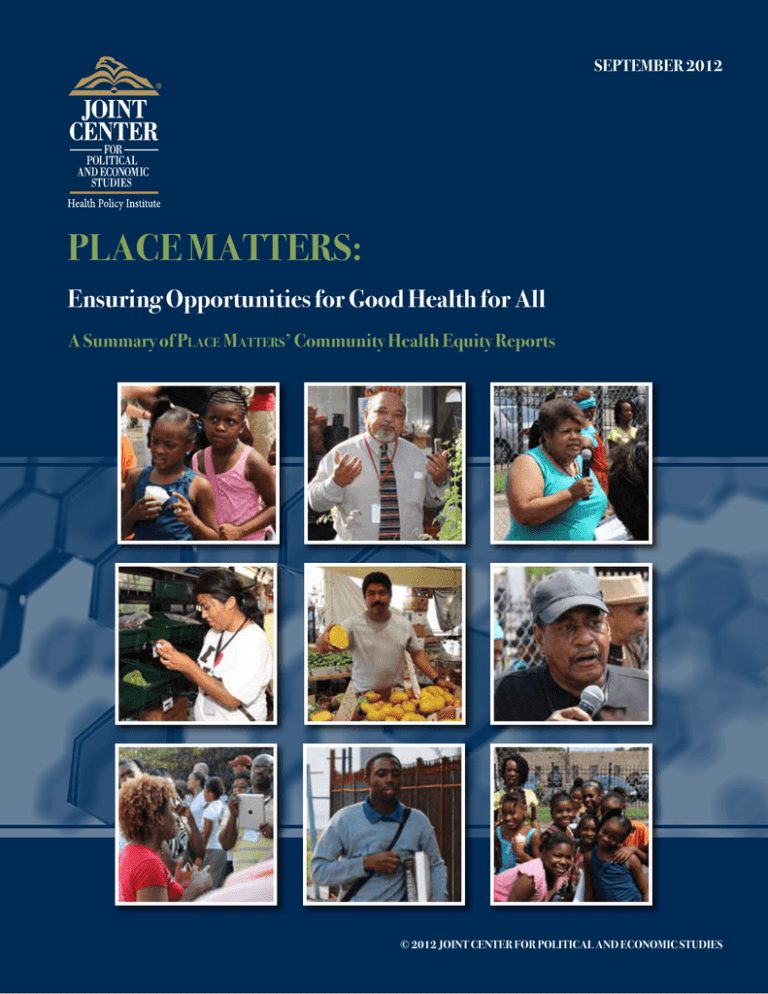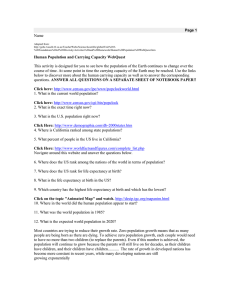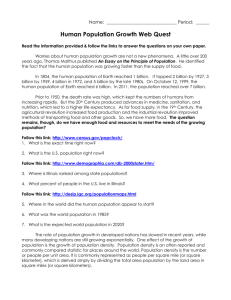
September 2012
Place MatterS:
Ensuring Opportunities for Good Health for All
A Summary of Place Matters’ Community Health Equity Reports
© 2012 Joint Center for Political and Economic Studies
Place Matters:
Ensuring Opportunities for Good Health for All
A Summary of Place Matters’ Community Health Equity Reports
Mike Wenger
Senior Fellow
Joint Center for Political and Economic Studies
Prepared by the
Joint Center for Political and Economic Studies
In Conjunction With
the Center on Human Needs, Virginia Commonwealth University
and The Virginia Network for Geospatial Health Research
Joint Center for Political and Economic Studies
September 2012
Opinions expressed in Joint Center publications are those of the authors and do not necessarily reflect the views of the staff, officers
or governors of the Joint Center for Political and Economic Studies or the organizations that support the Joint Center and its
research.
This research was supported by Award Number 1RC2MD004795-01 from the National Institute on Minority Health And
Health Disparities. The content is solely the responsibility of the authors and does not necessarily represent the official views of the
National Center on Minority Health And Health Disparities or the National Institutes of Health.
The Joint Center for Political and Economic Studies and the Place Matters initiative are supported by a generous grant from
the W.K. Kellogg Foundation.
Joint Center for Political and Economic Studies, Washington, DC 20005
www.jointcenter.org
© 2012
All rights reserved. Published 2012.
Printed in the United States.
Foreword
Place matters for health in important ways, according to a growing body of research. Differences in neighborhood conditions
powerfully predict who is healthy, who is sick, and who lives longer. And because of patterns of residential segregation, these
differences are the fundamental causes of health inequities among different racial, ethnic, and socioeconomic groups.
The Joint Center for Political and Economic Studies and its Place Matters Teams are pleased to add to the existing knowledge
base with this report, “Place Matters for Health: Ensuring Opportunities for Good Health for All.“ The report, supported by a
grant from the National Institute on Minority Health and Health Disparities (NIMHD) of the National Institutes of Health,
provides a summary of the analysis of the range of social, economic, and environmental conditions that exist in selected Place
Matters communities and documents their relationship to the health status of the residents.
The study finds that social, economic, and environmental conditions in low-income and non-white neighborhoods make it more
difficult for people in these neighborhoods to live healthy lives.
The overall pattern in the series of Community Health Equity Reports, as this summary makes clear, suggests that we need to tackle
the structures and systems that create and perpetuate inequality to fully close racial and ethnic health gaps. Accordingly, because
the Joint Center seeks not only to document these inequities, we are committed to helping remedy them.
Through our Place Matters initiative, which is generously supported by the W.K. Kellogg Foundation, we are working with
leaders in 24 communities around the country to identify and address social, economic, and environmental conditions that shape
health. We look forward to continuing to work with leaders these and other communities to ensure that every child, regardless of
their race, ethnicity, or place of residence, can enjoy the opportunity to live a healthy, safe, and productive life.
Ralph B. Everett
President and CEO
Joint Center for Political and Economic Studies
Place Matters: Ensuring Opportunities for Good Health for All
c
d
Joint Center for Political and Economic Studies
PLACE MATTERS Community Visits the Centers for New Horizon on a bus tour in Chicago.
Introduction
[I]nequities in health [and] avoidable health inequalities arise
because of the circumstances in which people grow, live, work,
and age, and the systems put in place to deal with illness. The
conditions in which people live and die are, in turn, shaped by
political, social, and economic forces.
World Health Organization Commission on the Social
Determinants of Health (2008)
Place matters for health. A large body of research demonstrates
that the spaces and places where people live, work, study, and
play have powerful direct and indirect influences on health
status. And because of persistent segregation in schools,
workplaces, and communities, many people of color are more
likely than whites to occupy spaces that are less conducive
to good health. Segregation is therefore, in the view of many
public health experts, a root cause of the racial and ethnic health
inequalities in the United States.
This policy brief summarizes findings from a series of
Community Health Equity Reports (CHERs) that the
Joint Center for Political and Economic Studies prepared in
collaboration with Place Matters teams. (For more about
these groups, please see the Appendix.) Since 2006, Place
Matters teams in 24 jurisdictions around the country have
been working to identify and address the social, economic, and
environmental conditions at the community level that result
in people of color living shorter and less healthy lives than
their white peers. While the challenges facing people in Place
Matters communities vary, a common theme emerged from
our research: when it comes to health, one’s zip code is often
more important than one’s genetic code.
Community conditions can overwhelm even the most
persistent and determined efforts of individuals to take steps
to improve their health. Neighborhoods characterized by
high levels of segregation are disproportionately burdened by
health risks, such as environmental degradation, often brought
about by a high density of polluting industries. It’s harder to
eat a healthy diet in these communities because there are fewer
grocery stores offering fresh fruits and vegetables. These same
communities are more likely to have poorer-quality housing
and transportation options, and are hit hardest by the homemortgage lending crisis, which crushed wealth opportunities
and disproportionately affected communities of color. Many
of these neighborhoods also experience high rates of crime
Place Matters: Ensuring Opportunities for Good Health for All
1
African Americans and white Americans as well as between
Hispanics and white Americans. A Joint Center study that
simulated how varying levels of segregation are associated with
racial gaps in rates of infant mortality showed that complete
black-white residential integration would result in at least two
fewer black infant deaths (2.31) per 1,000 live births. Had the
nation been fully integrated in 2008, this simulation indicated,
over 2,800 African American infant deaths would have been
averted. With full integration, Hispanics would have a lower
rate of infant mortality than whites.2
John Capitman speaks on behalf of the San Joaquin Valley Place Matters Team at the release of the
team’s Health Equity Report, Fresno, CA.
and violence, and even those who are not directly victimized
are hurt as a result of stress and an inability to exercise or play
outside. At the same time, too many of these neighborhoods
lack access to health-enhancing resources, such as safe places
to play and exercise. Even health care providers, hospitals, and
clinics are harder to find in these neighborhoods.
Segregation is associated with poorer health because it
concentrates poverty, thereby excluding and isolating people
of color from mainstream resources necessary for economic
mobility, such as good schools, good jobs, and access to banks
and capital for business development. African Americans,
Hispanics, and American Indians are substantially more likely
to live in high-poverty neighborhoods than non-Hispanic
whites. Today one in four African Americans, one in six
Hispanics, and one in eight American Indians in metropolitan
America lives in a census tract in which 30 percent or more of
the population is in poverty. These rates starkly contrast with
the estimated one in 25 non-Hispanic whites who live in one
of these tracts. But the high proportion of people of color
in high-poverty communities is not solely the result of class
differences: even middle- and higher-income minorities live
disproportionately in neighborhoods with high poverty.1
People of color are more likely to live in high-poverty
neighborhoods because of a host of historic and contemporary
factors that facilitate segregation, such as the ripple effects
of Jim Crow segregation, “redlining”—the now-banned
but persistent practice of disinvestment and economic
discrimination against communities of color—and
contemporary discrimination such as steering of minority
home-buyers or renters away from majority white communities.
Federal laws that prohibit housing discrimination effectively
helped to promote integration in many American cities, and
the nation saw a slight decline in residential segregation by
race between 2000 and 2010. But segregation continues to
be a predictor of significant health disparities, as measured by
divergent rates of infant mortality, in comparisons between
2
Documenting the Distribution of Health
in Place Matters Communities
In the eight communities we studied for this project, the data
reveal significantly greater health inequalities than nationally,
particularly with regard to life expectancy. And in every one of
the eight communities life expectancy is directly correlated with
income, educational attainment, accessibility of nutritious foods
and exercise, and environmental hazards. Furthermore, these
factors are interconnected and feed on each other, and children
are especially vulnerable in such situations.
For example, in the San Joaquin Valley of California, where
the Place Matters team focused on the ramifications of
environmental degradation, life expectancy varies by as much as
21 years depending on zip code. In the zip codes with lowest life
expectancy, people can expect to live to be only about 69 years
or less, while people can live to be 90 years or more in zip codes
with the highest life expectancy. Zip codes with the lowest life
expectancy tend to have a higher percentage of Hispanic and
low-income residents. The rate of premature deaths (deaths
before the age of 65) in the lowest-income zip codes in the
Valley is nearly twice that of those in the highest-income zip
codes. And areas of the San Joaquin Valley with the highest
levels of respiratory risk have the highest percentage of Hispanic
residents (55 percent), while areas with the lowest levels of
respiratory risk have the lowest percentage of Hispanic residents
(38 percent). One in six children in the San Joaquin Valley
is diagnosed with asthma before the age of 18, an epidemic
level. Illnesses in childhood such as asthma increase the risk for
poor educational outcomes—which in turn increases the risk
for poor health as an adult. The percentage of the population
without a high school diploma in the San Joaquin Valley (30
percent) is more than double the percentage of people in the
United States (14.7 percent) without a high school diploma.
According to national statistics, adults (age 25 and older)
without a high school diploma are three times more likely to die
before the age of 65 than those with a college education.
In Bernalillo County, N.M., which includes Albuquerque, our
study found that people living in neighborhoods characterized
by inadequate schools, poor housing, polluted environments,
insufficient transportation, and a lack of safety have a lower
Joint Center for Political and Economic Studies
Map 1: Life Expectancy by Census Tract, Bernalillo County, N.M. (2001-2005)
life expectancy than people living in neighborhoods that
don’t suffer from such negative characteristics. We further
found that communities that face the greatest array of health
risks have a larger percentage of low-income, immigrant, and
Hispanic families than communities that face the least health
risks. Specifically, we found more than a 22-year difference
in life expectancy across census tracts in the county (see Map
1), and a 12-fold difference in the percentage of low-birthweight infants across census tracts. We also found a wide
difference across census tracts in community-level health
risks, as measured by average educational attainment, average
standardized test scores, violent crime rates, home foreclosure
rates, unemployment rates, vacant housing, households with no
automobiles, and the percentage of overcrowded households.
We found an average life expectancy of 5.9 years less when a
neighborhood’s community risk index is high compared to
when a neighborhood’s community risk index is low. The study
also demonstrated a higher concentration of environmental
health hazards, such as air pollution and toxic industrial wastes,
in nonwhite and low-income census tracts than in whiter and
higher-income census tracts, and an average life expectancy of
5.2 years less in census tracts with the greatest concentration of
environmental hazards.
In New Orleans, our research found that life expectancy in
the poorest zip code in the city is 25.5 years lower than life
expectancy in the zip code with the least amount of poverty
(see Map 2). Heart disease mortality in the poorest zip code is
almost five times higher than the next highest rate in the city,
the lowest levels of educational attainment correlate with the
lowest rates of life expectancy, and the mortality rate in 2007
for African American residents, who live disproportionately
in neighborhoods of concentrated poverty, was 1.5 times the
mortality rate for white residents. The study also found a wide
difference across census tracts in a community-level risk index,
which was calculated by combining measures of population
Place Matters: Ensuring Opportunities for Good Health for All
3
Map 2: Life Expectancy by Zip Code in Orleans Parish, LA
below 150 percent of the federal poverty level, overcrowded
households, households without a vehicle, and vacant
housing. Areas with the highest community risk indexes have
significantly higher heart disease and stroke mortality rates. The
lowest levels of educational attainment by census tract (as many
as 72 percent of residents without a high school education)
correlate with the highest levels of community risk factors
and the lowest life expectancy rates. The study also found that
higher violent crime rates are associated with areas that have
higher rates of repopulation since Hurricane Katrina and lower
levels of educational attainment.
In Cook County, Ill., where access to healthy food is the
dominant issue for the Place Matters team, high levels of
racial, ethnic, and economic segregation have contributed to
persistent poverty concentration and, as a result, an inequitable
distribution of health. More than a quarter of the census tracts
experience persistent poverty, meaning that at least 20 percent
4
of households have been in poverty for two decades, and 162
census tracts have had at least 20 percent of residents in poverty
for five decades. People living in areas with a median annual
income greater than $53,000 have a life expectancy almost 14
years longer than that of people living in areas with a median
annual income below $25,000. In 2007 the premature death
rate for black residents was nearly 2.5 times the rate for white
residents. The research further found that most of the census
tracts with low educational attainment and low food access have
a high concentration of nonwhite residents (see Figure 1) and
that residents with the least access to chain supermarkets and
large independent grocers have an average life expectancy that is
approximately 11 years shorter than residents with the highest
access to such food providers.
Joint Center for Political and Economic Studies
Figure 1: Characteristics of Food Deserts and Non-Food Deserts in Cook County (2009)
Addressing Health Inequities
The overall pattern suggests that socioeconomic conditions in
neighborhoods of concentrated poverty, which in our studies
are predominantly African American and Hispanic American,
make it more difficult for people in these communities to
live healthy lives. It is astounding and should be unacceptable
that in the world’s wealthiest society a person’s life can be cut
short by two decades or more simply because of where one
lives and factors over which he or she has no control. Clearly,
there is a strong moral imperative to enact policies to redress
the inequities of the past, as well as current inequities, in ways
that will improve health for all. But there also is a powerful
economic incentive. A study released by the Joint Center in
2009 found that direct medical costs associated with health
inequities among African Americans, Hispanics, and Asian
Americans approached $230 billion between 2003 and 2006.
When indirect costs, such as lowered productivity and lost
tax revenue resulting from illness and premature death, were
included, the total cost of health inequities exceeded $1.24
trillion.3 Thus, for both moral and economic reasons, we must
address health inequities and their root causes now.
A place-based approach to health disparities and inequities is
clearly indicated by our research. The hopeful finding in every
community we studied is that people, many of them members
of Place Matters teams, are hard at work seeking to change
the conditions that foster health inequities. For example, in the
San Joaquin Valley, several strategies for addressing inequities
emerged from the San Joaquin Valley Regional Equity
Forum staged by the Central Valley Health Policy Institute at
California State University in Fresno. Representatives of several
of the largest regional social justice coalitions participating in
the San Joaquin Valley Place Matters team have developed
consensus recommendations to guide elected officials, policy
makers, planners, philanthropic organizations, and other
stakeholders. The broad conclusion is that focusing on creating
the physical and institutional infrastructure for access to
basic determinants of health and well-being, while ensuring
that communities have the political power to make certain
that policies and practices respond to their interests, offers a
framework for shared action by the San Joaquin Valley Place
Matters team and its allies.
Place Matters: Ensuring Opportunities for Good Health for All
5
A representative from the Fresh Moves Mobile Bus shares information about their work with the Place Matters community in Chicago.
In Bernalillo County members of the Place Matters team
have been strong advocates for policies to help ensure that lowincome and Hispanic communities are not disproportionately
hurt by environmental degradation and policies or practices that
cluster health risks. In Orleans Parish, the Place Matters
team has chosen to focus on keeping children in quality
schools and on providing access to educational services for
youth and adults who have been out of school for significant
periods of time. Because higher crime rates correlate with lower
educational attainment, the team is now broadening its focus
to include ways in which to decrease the incidence of violent
crime.
Metropolitan Chicago has several organizations and individuals
active in a multifaceted and vibrant food justice movement
designed to combat one of the negative consequences of
concentrated poverty: inadequate access to healthy foods and
the resultant detrimental impact on health outcomes. The
Cook County Place Matters team has identified some
values to serve as guideposts: racial equity, social justice, and
empowerment of voices usually not heard in the policy-making
process. While the focus of Cook County’s Place Matters
team is on access to food and food justice, the team also
recognizes the importance to health equity of transportation,
6
housing, employment, education, health care, and meaningful
participation of Cook County residents in the democratic
process.
Recommendations specific to each location, designed to ensure
opportunities for good health for all, can be found in the
CHER for each location. Among the recommendations are
strategies to:
•
Increase understanding of the social determinants
of health among elected policy makers, community
leaders, and health, social service, education, and
community/economic development professionals
through professional education and other tools;
•
Monitor on an ongoing basis environmentally
challenged and socioeconomically vulnerable
communities and increase public sector efforts to
engage with—and invest in—these communities;
•
Aggressively tackle poverty by fully funding programs
that focus on early childhood development and
economic development (including job training
incentives and enterprise and empowerment zones);
Joint Center for Political and Economic Studies
•
Adopt land use policies that reflect an emphasis
on smart and equitable growth, facilitate access to
affordable housing for vulnerable populations, and
promote housing mobility to help reduce the clustering
of people in neighborhoods of concentrated poverty
and in areas where exposure to environmental risks is
highest;
•
Keep youth in school and reduce risks for involvement
in juvenile justice and criminal justice systems by
reducing school expulsions and suspensions, and
offering alternatives to incarceration including schoolbased teen courts, peer mediation programming, and
restorative justice programming;
•
Implement a public financing program to provide
financial “seed money” to stimulate healthy food retail
in neighborhoods with low food access;
•
Increase the capacity of communities to hold decision
makers accountable through building the capacity
of grassroots/community leaders and through
encouraging support for collaborative decision making
and advocacy to address regional challenges;
•
Require public decision makers and program
implementers to consider the impacts of proposed
actions on racial/ethnic equity in life opportunities,
health, and well-being, and to adjust actions to
maximize this goal. This equity in all policies approach
should also be adopted by philanthropic and religious
groups and other organizations serving the region.
our history of racial oppression and racial segregation. But
health inequities ultimately affect all Americans. Eliminating
these inequities requires that we confront and overcome the
conditions brought about by racism.
No matter how challenging these institutional barriers to
good health may be, the vast majority of communities possess
sources of potential strength that can help in important ways
to overcome these barriers. In his work on the concept of
social capital, Robert Putnam has explored these potential
strengths. He defines social capital as “connections among
individuals—social networks and the norms of reciprocity and
trustworthiness that arise from them.” Thus, when connections
in a community are strong, the ability of the community to
counteract institutional barriers that mitigate against good
health outcomes is increased. The World Bank calls social
capital “the glue that holds (societies) together.”
“Community connectedness” says Putnam, “is not just about
warm fuzzy tales of civic triumph. In measurable and welldocumented ways, social capital makes an enormous difference
to our lives.”
Thus, just as place matters in health outcomes, relationships also
matter in health outcomes. If relationships in a community are
strong, its residents are more likely to act collectively, through
organized and intentional actions, to significantly influence
public policies related to social determinants of health. And,
in fact, the commitment of a core group of dedicated residents,
working closely together, can bring enduring change. As the
highly respected anthropologist Margaret Mead perceptively
stated:
Never doubt that a small group of thoughtful,
committed people can change the world;
indeed, it’s the only thing that ever has.
Conclusion
Interaction enables people to build communities, to commit
themselves to each other, and to knit the social fabric.
Robert Putnam, Professor of Public Policy, Harvard University
Research provides clear evidence that residents of
neighborhoods characterized by such conditions as persistent
poverty, low educational attainment, exposure to greater
levels of violence and environmental hazards, and lack
of access to health care providers, nutritious foods, and
exercise facilities generally have significantly poorer health
outcomes than residents of neighborhoods that are not
plagued by such conditions. These institutional barriers to
good health, often called social determinants of health, lead
to higher rates of infant mortality and low-birth-weight
babies, greater susceptibility to cardiovascular and respiratory
diseases, increased occurrences of premature death, and, on
average, shorter life expectancy. Such neighborhoods are
disproportionately populated by people of color, a legacy of
Because those seeking change often confront resistance from
those who prefer the status quo, success requires the type of
courage and dedication so aptly described by Dr. Vincent
Harding, a close former associate of Dr. Martin Luther King, Jr.:
If you don’t ever walk through trouble, or
confront a risk, or reach beyond your comfort
zone, you will never meet the rest of yourself.
Building a dynamic movement that succeeds in eliminating
health disparities and achieving health equity requires a level
of courage and commitment that is inherent in all of us if we
choose to exercise it.
Place Matters: Ensuring Opportunities for Good Health for All
7
Appendix
•
Engage target audiences, such as policy makers,
community leaders, elected officials, faith leaders, the
news media, civic leaders, and others, to help mitigate
adverse conditions;
•
Provide an evidence-based “dashboard” for identifying
pockets of extreme distress and for tracking progress/
setbacks over time in addressing health disparities and
socioeconomic well-being within the community.
About the Joint Center, Place Matters, and its
Community Health Equity Reports
The Health Policy Institute (HPI) of the Joint Center for
Political and Economic Studies was created to help build a
health equity movement that will give all people an equal
opportunity to live healthy lives. It focuses attention on the
array of factors that damage the health of many people of color,
and it promotes promising policy strategies to address these
factors. Through its research, the Institute analyzes the root
causes of the poorer health of minority groups, ranging from the
clustering of health risks in communities of color to insufficient
access to quality health care, and it works to raise stakeholder
awareness and engagement and promote policy solutions to
address these problems.
Place Matters, an HPI initiative supported largely by the
W.K. Kellogg Foundation, is a national learning laboratory that
currently consists of 16 teams working in 24 cities and counties.
This learning laboratory seeks to foster local understanding
of strategies to improve health outcomes and narrow health
disparities through research, community capacity-building, and
policy engagement. Using a community-based participatory
model, Place Matters teams identify priority health
concerns of low-income communities and communities of color
(e.g., infant mortality, childhood obesity, youth violence) and
build support for interventions that address underlying social,
economic, and environmental conditions that shape these
health outcomes. These conditions are recognized as social
determinants of health.
In August 2009, HPI received a grant from the National
Institute on Minority Health and Health Disparities of the
National Institutes of Health (NIH) to develop and disseminate
locally tailored Community Health Equity Reports (CHERs)
in eight communities where Place Matters teams are in
operation. The objectives of CHERs are to assess population
health inequities and social and economic conditions in each of
the eight communities. The development and dissemination of
such locally tailored CHERs will help the participating Place
Matters teams to:
8
•
Identify and assemble indicators of health status and
community conditions in their target geographic areas;
•
Identify potential relationships between social and
economic conditions and community health status, to
inform policy within the target communities, and to
deepen understanding of the interconnections between
the local social environment and health disparities;
To conduct the background research and produce technical
reports for each of the eight communities, HPI contracted
with the Center on Human Needs (CHN) at Virginia
Commonwealth University. CHN’s role was to work with
the Place Matters communities to identify community
indicators and data analysis needs, collect and analyze data, and
create a technical report for each community. It coordinated
with the Virginia Network for Geospatial Health Research
(VaNGHR) to geocode the data and create analytic maps to
portray geographic disparities in the participating communities.
The eight participating communities in this project are
Alameda County, Calif.; Baltimore, Md.; Bernalillo County,
N.M.; Boston, Mass.; Cook County, Ill.; Orleans Parish, La.;
San Joaquin Valley, Calif.; and South Delta, Miss. For each
community the local Place Matters team, usually composed
of community leaders, public health department officials, and
other key stakeholders, developed the key questions it wanted
the data gathering and analysis to address. CHN then gathered
and analyzed the data and incorporated its findings into the
technical report for each community. Using the data from these
technical reports, HPI has prepared a CHER for each of the
eight communities. Prior to completion and public release each
CHER is reviewed by the appropriate Place Matters team.
Although not all of the CHERs have yet been publicly released,
we can, from the findings of the reports and from related
research, summarize the work that has been done and draw
some conclusions.
Joint Center for Political and Economic Studies
Endnotes
1 Pendall R, Davies E, Freiman L, and Pitingolo R. (2011).
“A Lost Decade: Neighborhood Poverty and the Urban Crisis
of the 2000s.” Washington, D.C.: Joint Center for Political and
Economic Studies.
2 LaVeist T, Gaskin D, and Trujillo A. (2011). “Separate
Spaces, Risky Places: The Effects of Racial Segregation on
Health Inequalities.” Washington, D.C.: Joint Center for
Political and Economic Studies
3 LaVeist T, Gaskin D, and Richard P. (2009). “The
Economic Burden of Health Inequalities.” Washington, D.C.:
Joint Center for Political and Economic Studies.
Place Matters: Ensuring Opportunities for Good Health for All
9
BOARD OF GOVERNORS
August 2012
Cynthia G. Marshall, Chair
President
AT&T North Carolina
Robert R. Hagans, Jr., Treasurer
Executive Vice President
and Chief Financial Officer
AARP
Dwight L. Bush, Vice Chair
Managing Director
D.L. Bush & Associates
Barbara L. Johnson, Esq., At Large
Partner
Paul Hastings LLP
Ralph B. Everett, Esq.
President and Chief Executive Officer
Lawrence D. Bobo, Ph.D.
W.E.B. DuBois Professor
of the Social Sciences
Department of Sociology
Harvard University
Marva Smalls
Executive Vice President of Global
Inclusion Strategy, MTV Networks
& Executive Vice President
of Public Affairs, and Chief of Staff
Nickelodeon/MTVN Kids & Family Group
Donna Brazile
Founder and Managing Director
Brazile & Associates L.L.C.
The Honorable Carolyn C. Kilpatrick
Managing Partner
J & A Global Partners, L.L.C.
Reed V. Tuckson, M.D., FACP
Executive Vice President and Chief
of Medical Affairs
UnitedHealth Group
Freada Kapor Klein, Ph.D.
Trustee
Mitchell Kapor Foundation
Robert L. Mallett, Esq.
The Peter P. Mullen Visiting
Professor of Law
Georgetown University Law Center
Cynthia M. Bodrick
Assistant Secretary of the Corporation
The Honorable J.C. Watts, Jr.
Chairman
J.C. Watts Companies
MEMBERS EMERITI
Dr. William B. Boyd
President Emeritus
The Johnson Foundation
Eddie N. Williams
President
Eddie Williams and
and Associates, LLC
James D. Wolfensohn
President & CEO
Wolfensohn and Company
FOUNDERS
Dr. Kenneth B. Clark
Served from 1970 to 2005
Louis E. Martin
Served from 1970 to 1997
Joint Center for Political and Economic Studies
805 Fifteenth Street, NW, 2nd Floor
Washington, DC 20005
www.jointcenter.org
This product is printed on paper that is 50% recycled, 30% post consumer, Elemental Chlorine Free (ECF), and acid free.




